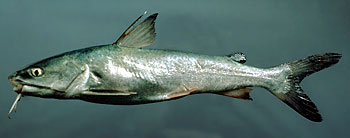Hardhead Sea Catfish
Hardhead Sea Catfish Sounds (Ariopsis felis)
Description

Courtesy of Don Flescher.
The Hardhead Catfish ranges from Massachusetts to southern Mexico and is common over muddy or sandy bottoms of bays and shallow coastal waters. Spawning occurs in back bays during the spring and summer months. Like many species of catfish, the hardhead is a mouth brooder. The male retains the fertilized eggs in his mouth until hatching occurs – a period of up to eighty days! For a short time after hatching (up to two weeks) juveniles will remain in or return to the adult’s mouth for protection. During this time the adult male does not feed. The reproductive strategy of this species is an example of a very high degree of paternal care. Both males and females reach maturity by their second year and reach maximum ages of about eight years.Evidence exists to suggest that sound production in this species may be quite differentiated in terms of mechanism and context. Thin bones connect to the surface of the swim bladder and are vibrated by a pair of specialized sonic muscles. Sound is also produced by stridulation of the pectoral spines against the pectoral girdle and by grinding of the pharyngeal teeth. Upon capture (by hook and line) the latter two methods appear to be used as a fright response. Tavolga (1977) made a convincing argument that a crude form of sonar is employed by this species where sounds produced appeared to be used as a form of echolocation (which also indicates directional hearing abilities). It is also likely that sound production is associated with courtship and spawning and possibly other social behavior as well.